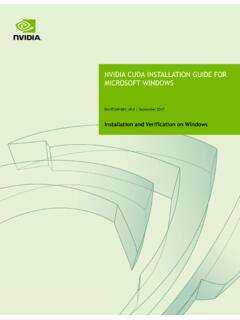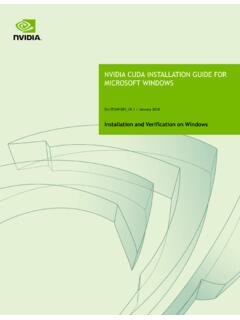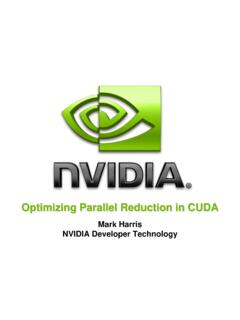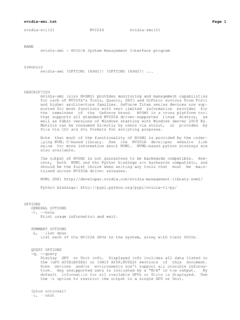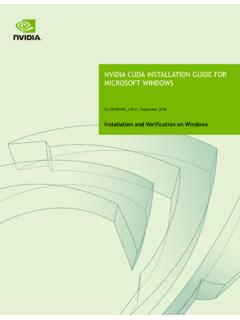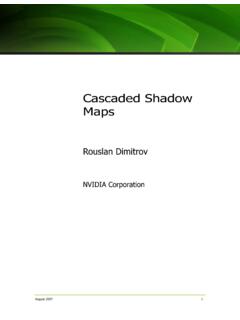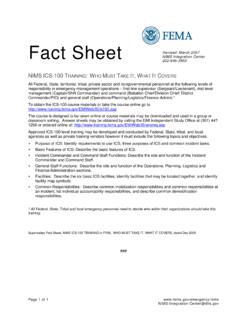Transcription of CUDA by Example - Nvidia
1 cuda by Example An introduction to General-Purpose GPU Programming Jason Sanders Edward Kandrot Upper Saddle River, NJ Boston Indianapolis San Francisco New York Toronto Montreal London Munich Paris Madrid Capetown Sydney Tokyo Singapore Mexico City 3 6/12/10 3:15:14 PM. Many of the designations used by manufacturers and sellers to distinguish their products are claimed as trademarks. Where those designations appear in this book, and the publisher was aware of a trademark claim, the designations have been printed with initial capital letters or in all capitals. The authors and publisher have taken care in the preparation of this book, but make no expressed or implied warranty of any kind and assume no responsibility for errors or omissions. No liability is assumed for incidental or consequential damages in connection with or arising out of the use of the information or programs contained herein. Nvidia makes no warranty or representation that the techniques described herein are free from any Intellectual Property claims.
2 The reader assumes all risk of any such claims based on his or her use of these techniques. The publisher offers excellent discounts on this book when ordered in quantity for bulk purchases or special sales, which may include electronic versions and/or custom covers and content particular to your business, training goals, marketing focus, and branding interests. For more information, please contact: Corporate and Government Sales (800) 382-3419. For sales outside the United States, please contact: International Sales Visit us on the Web: Library of Congress Cataloging-in-Publication Data Sanders, Jason. cuda by Example : an introduction to general-purpose GPU programming /. Jason Sanders, Edward Kandrot. p. cm. Includes index. ISBN 978-0-13-138768-3 (pbk. : alk. paper). 1. Application software Development. 2. Computer architecture. 3. Parallel programming (Computer science) I. Kandrot, Edward. II. Title. 2010. '75 dc22. 2010017618. Copyright 2011 Nvidia Corporation All rights reserved.
3 Printed in the United States of America. This publication is protected by copy- right, and permission must be obtained from the publisher prior to any prohibited reproduction, storage in a retrieval system, or transmission in any form or by any means, electronic, mechanical, photocopying, recording, or likewise. For information regarding permissions, write to: Pearson Education, Inc. Rights and Contracts Department 501 Boylston Street, Suite 900. Boston, MA 02116. Fax: (617) 671-3447. ISBN-13: 978-0-13-138768-3. ISBN-10: 0-13-138768-5. Text printed in the United States on recycled paper at Edwards Brothers in Ann Arbor, Michigan. First printing, July 2010. 4 6/12/10 3:15:14 PM. Contents Foreword .. xiii Preface .. xv Acknowledgments .. xvii About the Authors .. xix 1 Why cuda ? Why Now? 1. Chapter Objectives .. 2. The Age of Parallel Processing .. 2. Central Processing Units .. 2. The Rise of GPU Computing .. 4. A Brief History of GPUs .. 4. Early GPU Computing.
4 5. cuda .. 6. What Is the cuda Architecture? .. 7. Using the cuda Architecture .. 7. Applications of cuda .. 8. Medical Imaging .. 8. Computational Fluid Dynamics .. 9. Environmental Science .. 10. Chapter Review .. 11. vii 7 6/12/10 3:15:14 PM. Contents 2 Getting Started 13. Chapter Objectives .. 14. Development Environment .. 14. cuda -Enabled Graphics Processors .. 14. Nvidia Device Driver .. 16. cuda Development Toolkit .. 16. Standard C Compiler .. 18. Chapter Review .. 19. 3 introduction to cuda C 21. Chapter Objectives .. 22. A First Program .. 22. Hello, World! .. 22. A Kernel Call .. 23. Passing Parameters .. 24. Querying Devices .. 27. Using Device Properties .. 33. Chapter Review .. 35. 4 Parallel Programming in cuda C 37. Chapter Objectives .. 38. cuda Parallel Programming .. 38. Summing Vectors .. 38. A Fun Example .. 46. Chapter Review .. 57. viii 8 6/12/10 3:15:14 PM. Contents 5 Thread Cooperation 59. Chapter Objectives .. 60. Splitting Parallel Blocks.
5 60. Vector Sums: Redux .. 60. GPU Ripple Using Threads .. 69. Shared Memory and Synchronization .. 75. Dot Product .. 76. Dot Product Optimized (Incorrectly) .. 87. Shared Memory Bitmap .. 90. Chapter Review .. 94. 6 Constant Memory and Events 95. Chapter Objectives .. 96. Constant Memory .. 96. Ray Tracing introduction .. 96. Ray Tracing on the GPU .. 98. Ray Tracing with Constant Memory .. 104. Performance with Constant Memory .. 106. Measuring Performance with Events .. 108. Measuring Ray Tracer Performance .. 110. Chapter Review .. 114. 7 Texture Memory 115. Chapter Objectives .. 116. Texture Memory Overview .. 116. ix 9 6/12/10 3:15:15 PM. Contents Simulating Heat Transfer .. 117. Simple Heating Model .. 117. Computing Temperature Updates .. 119. Animating the Simulation .. 121. Using Texture Memory .. 125. Using Two-Dimensional Texture Memory .. 131. Chapter Review .. 137. 8 Graphics Interoperability 139. Chapter Objectives .. 140. Graphics Interoperation.
6 140. GPU Ripple with Graphics Interoperability .. 147. The GPUAnimBitmap Structure .. 148. GPU Ripple Redux .. 152. Heat Transfer with Graphics Interop .. 154. DirectX Interoperability .. 160. Chapter Review .. 161. 9 Atomics 163. Chapter Objectives .. 164. Compute Capability .. 164. The Compute Capability of Nvidia GPUs .. 164. Compiling for a Minimum Compute Capability .. 167. Atomic Operations Overview .. 168. Computing Histograms .. 170. CPU Histogram Computation .. 171. GPU Histogram Computation .. 173. Chapter Review .. 183. x 10 6/12/10 3:15:15 PM. Contents 10 Streams 185. Chapter Objectives .. 186. Page-Locked Host Memory .. 186. cuda Streams .. 192. Using a Single cuda Stream .. 192. Using Multiple cuda Streams .. 198. GPU Work Scheduling .. 205. Using Multiple cuda Streams Effectively .. 208. Chapter Review .. 211. 11 cuda C on Multiple GPUs 213. Chapter Objectives .. 214. Zero-Copy Host Memory .. 214. Zero-Copy Dot Product .. 214. Zero-Copy Performance.
7 222. Using Multiple GPUs .. 224. Portable Pinned Memory .. 230. Chapter Review .. 235. 12 The Final Countdown 237. Chapter Objectives .. 238. cuda Tools .. 238. cuda Toolkit .. 238. CUFFT .. 239. CUBLAS .. 239. Nvidia GPU Computing SDK .. 240. xi 11 6/12/10 3:15:15 PM. C ontents Nvidia Performance Primitives .. 241. Debugging cuda C .. 241. cuda Visual Profiler .. 243. Written Resources .. 244. Programming Massively Parallel Processors: A Hands-On Approach .. 244. cuda U .. 245. Nvidia Forums .. 246. Code Resources .. 246. cuda Data Parallel Primitives Library .. 247. CULA tools .. 247. Language Wrappers .. 247. Chapter Review .. 248. A Advanced Atomics 249. Dot Product Revisited .. 250. Atomic Locks .. 251. Dot Product Redux: Atomic Locks .. 254. Implementing a Hash Table .. 258. Hash Table Overview .. 259. A CPU Hash Table .. 261. Multithreaded Hash Table .. 267. A GPU Hash Table .. 268. Hash Table Performance .. 276. Appendix Review .. 277. Index.
8 279. xii 12 6/12/10 3:27:28 PM. Preface This book shows how, by harnessing the power of your computer's graphics process unit (GPU), you can write high-performance software for a wide range of applications. Although originally designed to render computer graphics on a monitor (and still used for this purpose), GPUs are increasingly being called upon for equally demanding programs in science, engineering, and finance, among other domains. We refer collectively to GPU programs that address problems in nongraphics domains as general-purpose. Happily, although you need to have some experience working in C or C++ to benefit from this book, you need not have any knowledge of computer graphics. None whatsoever! GPU. programming simply offers you an opportunity to build and to build mightily . on your existing programming skills. To program Nvidia GPUs to perform general-purpose computing tasks, you will want to know what cuda is. Nvidia GPUs are built on what's known as the cuda Architecture.
9 You can think of the cuda Architecture as the scheme by which Nvidia has built GPUs that can perform both traditional graphics- rendering tasks and general-purpose tasks. To program cuda GPUs, we will be using a language known as cuda C. As you will see very early in this book, cuda C is essentially C with a handful of extensions to allow programming of massively parallel machines like Nvidia GPUs. We've geared cuda by Example toward experienced C or C++ programmers who have enough familiarity with C such that they are comfortable reading and writing code in C. This book builds on your experience with C and intends to serve as an Example -driven, quick-start guide to using Nvidia 's cuda C program- ming language. By no means do you need to have done large-scale software architecture, to have written a C compiler or an operating system kernel, or to know all the ins and outs of the ANSI C standards. However, we do not spend time reviewing C syntax or common C library routines such as malloc() or memcpy(), so we will assume that you are already reasonably familiar with these topics.
10 Xv 15 6/12/10 3:15:16 PM. Preface You will encounter some techniques that can be considered general parallel programming paradigms, although this book does not aim to teach general parallel programming techniques. Also, while we will look at nearly every part of the cuda API, this book does not serve as an extensive API reference nor will it go into gory detail about every tool that you can use to help develop your cuda C. software. Consequently, we highly recommend that this book be used in conjunc- tion with Nvidia 's freely available documentation, in particular the Nvidia cuda . Programming Guide and the Nvidia cuda Best Practices Guide. But don't stress out about collecting all these documents because we'll walk you through every- thing you need to do. Without further ado, the world of programming Nvidia GPUs with cuda C awaits! xvi 16 6/12/10 3:15:16 PM. Chapter 4. Parallel Programming in cuda C. In the previous chapter, we saw how simple it can be to write code that executes on the GPU.
